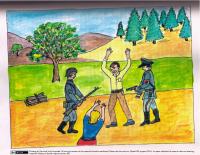Oral History: How to focus and structure a life history interview III

Drawing by G. L. Fernandez: to illustrate his life story
Introduction
One of the purposes of a life history interview is to recollect and preserve the voices of people who may not have had the opportunity to speak about their lives and histories before. Among such voices are those of people traditionally marginalized from official national histories. Migrants, exiles, women, children, the working classes are an example of such marginal voices. Documenting the life histories of these groups helps us to understand complex social, political and cultural processes such as migration, imperialism, exploitation, oppression, political violence, war, conflict, exclusion etc. while at the same time documenting key historical moments and contexts.
Objectives
In order to succeed in collecting rich oral data when interviewing specific groups of peoples, such as first generations of migrants, questions should be developed around specific areas, in order to explore relevant themes.
In these activities, you will learn how to identify key areas and themes to explore when conducting life history interviews with migrants and exiles.
Activity 1: Exploring specific themes for specific groups of people
In this activity, you will consider the themes that you may wish to explore if you were interviewing migrants or exiles.
Instruction
Read the themes listed below. Mark the ones that you think should be included in an interview plan for a group of migrants or exiles. Tick any that you think apply.
Activity 2: Using a thematic approach effectively
In this activity, you will listen to an audio extract in which researcher, Alicia Pozo-Gutiérrez, explains how themes help us to structure an oral history interview. Taking the themes identified in activity 1, she discusses why collecting memories thematically in this way helps in understanding migration processes and experiences. She notes that is useful to divide questions into two categories: factual and analytical. Making this distinction can help you in structuring both interview questions and your research notes.
Instruction
Listen to the extract below by clicking on the link. Read each example and decide whether it could be categorised as factual or analytical. Then read the feedback.
Audio extract - Alicia Pozo-Gutierrez
1. Reasons for migration
2. Racism experienced
3. Age when emigrated/returned home
4. Relationships at work
5. Maintaining own values and beliefs
What is Alicia's advice when putting questions in analytical categories?
Additional Resources
Click on the link below to listen to this interview with Corsino Fernandez Garcia, conducted by Alicia Pozo-Gutierrez, of the University of Southampton, on 3rd July, 2008. It is in English and is in three parts. It features Corsino talking about his early life and experiences as a child refugee during and after the Spanish civil war. Reflect on what you can learn about his sense of 'belonging'.
You can also view Luis Argeo's film "Corsino by Cole Kivlin" to expand on your reflections about the themes mentioned in Activity 1 above. In doing so, compare and contrast the oral narrative obtained directly through the life history interview with that presented in the audio-visual documentary. Consider, for instance, issues of voice, narrator, editing issues, potential audiences and likely reactions and impact.
© Irina Nelson and Alicia Pozo-Gutiérrez, University of Southampton. / Padmini Broomfield - Oral Historian. This work is licensed under a Creative Commons Attribution-NonCommercial-ShareAlike 3.0 Unported License
Created using the LOC Tool, University of Southampton